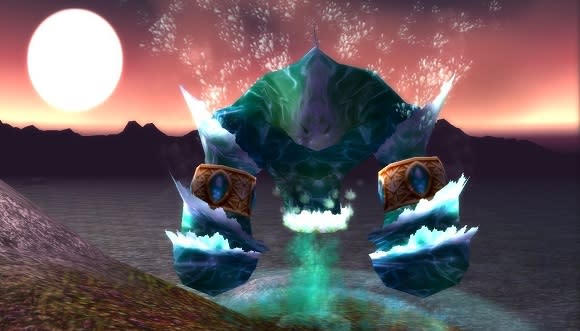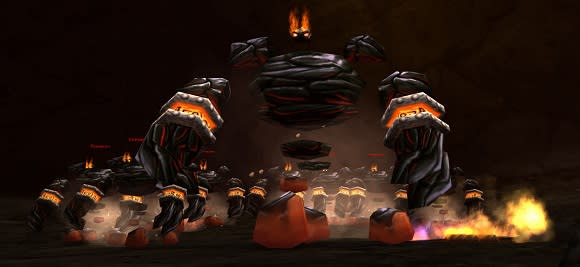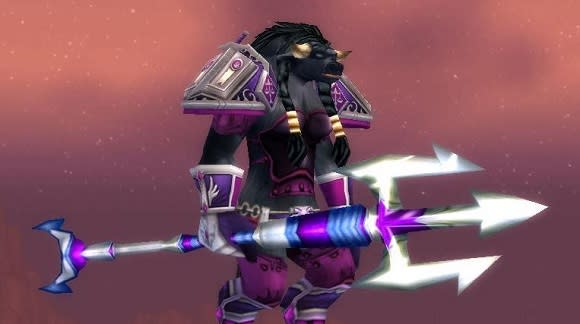WoW Archivist: The classic Molten Core experience, part 2

WoW Archivist explores the secrets of World of Warcraft's past. What did the game look like years ago? Who is etched into WoW's history? What secrets does the game still hold?
In the last WoW Archivist, we covered the early parts of Molten Core: the "attunement," the grueling trash clear to Lucifron, and the weird hunter-focused mechanics of Magmadar. As we left off, the raid had just reached its first rune. To douse the rune and (eventually) summon Majordomo Executus, you had to make friends with an angry royal guy made of water.
The duke of douse
Duke Hydraxis, as a water elemental, wasn't very fond of other elemental types, particularly Ragnaros or his fiery kin. His Hydraxian Waterlords were the first raid-based reputation in WoW. You could rep up with them before setting foot in Molten Core by killing certain elementals out in the world, but only up to just shy of honored. After that, you had to run MC to get additional rep. Trash gave rep until revered, but only boss kills got you through the slow grind to exalted.
Meanwhile, you could complete a small quest chain for the Duke. He first sent you to kill elementals in Plaguelands and Silithus, and then to obtain an item from Pyroguard Emberseer in Blackrock Spire. Further quests involved killing specific trash mobs and bosses in Molten Core. Hands of the Enemy quite literally asked you to bring him the severed hands of Lucifron, Gehennas, Shazzrah, and Sulfuron. Once completed, you could loot the duke's coffer and choose one of two very valuable fire resistance rings. At this point, the duke also gave you an Aqual Quintessence, one of the most famous items from classic WoW.
The quintessence allowed you to douse a rune. In all, you had to douse seven runes, one for each boss (minus Lucifron), in order to summon Executus and progress. However, the quintessence was consumable, and the duke only gave you one per week. So you needed a minimum of seven players to reach honored with the Waterlords before you could face the Majordomo.

Given that the waterlords hung out on a random rock far out into Azshara's bay, it wasn't exactly convenient to obtain the quintessence every week, especially for Alliance players. At revered, the duke mercifully granted you an Eternal Quintessence that wasn't consumable. The Eternal version didn't exist until late in classic, however -- it was added in patch 1.11.
Because the item was so necessary for Molten Core and such a hassle to retrieve every week, players remember it with a mixture of nostalgia and enmity. A quintessence is no longer obtainable, but if you earned one before they were patched out in Wrath of the Lich King, you now have the feat of strength The Fifth Element. For those who never did, you can get a Counterfeit Aqual Quintessence from a Brawler's Guild purse and pretend.
A forgettable flamewaker
After Magmadar, your guild faced another harrowing passage back through the imp cave to reach Gehennas. Gehennas is probably the most forgettable boss in the entire zone. He has the same model as other flamewakers, two flamewaker adds that could AOE stun, a Rain of Fire that you shouldn't stand in, and one Mortal Strike-type curse to decurse. Without a nearby imp cave to aggro like Lucifron, he was probably the easiest boss in MC. He had no notable loot besides tier pieces.
Eight is enough
Next up was Garr, the enormous lava elemental and his eight infuriating friends. The key to success here had little to do with execution during the encounter and virtually everything to do with player targeting prior to the pull.
All eight adds plus the boss had to be accounted for, either with tanks or crowd control. Warlocks' Banish spell once again came in handy here. The trick was to get everyone assigned to a Firesworn on a different target. In today's WoW, that would be trivial, since raid markers could be set on each one and assigned without trouble. But raid markers didn't exist in 2005. Making matters worse, the adds constantly shifted positions under Garr.
Raid leaders were the ones who had to coordinate this mess. Most often, they targeted the adds one by one and told players to use the /assist command to find their assignment. The first five minutes of every Garr pull were spent saying "Tank X, assist me for your target. OK, now Tank Y, assist me for your target. Now Warlock Z, assist me." In a world without dual spec, classes who weren't spec'ed for tanking became called on to survive the adds while the raid burned down their targets. Rogues with Evasion made for capable temporary tanks here.

If the raid leader screwed up the assignments on the churning adds, it often meant a difficult or disastrous attempt. Modern raid markers, in large part, were inspired by the Garr fight. Like the Eternal Quintessence, markers came to the rescue very late in classic, via patch 1.11.
The actual Garr encounter wasn't very difficult. His adds did AOE damage, so spreading active adds around the room (with assigned healers), was essential. Garr himself had a snare and an Antimagic Pulse ability that dispelled one buff from every player. Players could "game" the ability somewhat by giving themselves pointless buffs.
Once Garr was killed, the annoying Lava Surgers would no longer respawn. Notable drops included
Tier 1 helms
The coolest shield in classic, Drillborer Disk
After patch 1.6, if your raid was crazy lucky, the right half of the Bindings of the Windseeker to start the Thunderfury questline
The most famous pull in WoW
After clearing more trash, you reached the room that contained both Shazzrah and Baron Geddon. Fighting them both at once wasn't really an option. Shazzrah was tucked away in the back, while the Baron pathed in and out of the room. The best solution was to pull the Baron back into Garr's area and fight him there.
The pull was tricky. Geddon patrolled at a brisk pace, so timing was crucial. Once again the pull fell to hunters.
Eyes of the Beast (R.I.P.) was the tried and true method. You took control of your pet, aggroed the Baron, and then canceled the spell. It often took several attempts, since you couldn't see where he was in his long patrol when you sent the pet, and Eyes only lasted 1 minute. Once aggroed, the massive fire elemental came barreling down the hallway toward the raid and your tanks could pick him up.

The baron of burn
Baron Geddon's most notorious ability was Living Bomb. When you were debuffed with this, you had eight seconds to get away from everyone else before you exploded. That seems like plenty of time, but without the fancy boss addons of modern WoW, realizing you had the debuff wasn't always immediate. Many, many players accidentally blew up their raidmates this way. And, of course, some did it on purpose for their own amusement.
When the bomb went off, you not only took fire damage -- the explosion sent you high into the air, and you took falling damage on landing. Since you were often out of range of healers when you exploded, the combo was enough to kill many players, especially in rare dungeon gear. You had to use a health potion, healthstone, or personal cooldown before you hit the ground.
Originally, Living Bomb could also be cast on pets. Players soon learned that if they dismissed their pets with the debuff active, Living Bomb would remain. Then they could resummon their pets in a populated area, such as an auction house, and blow up unsuspecting shoppers. Blizzard later made pets untargetable to prevent such shenanigans.
Mages, of course, received the Living Bomb spell in Wrath of the Lich King as a tribute to Baron Geddon.
The Baron also had a few other damaging abilities, including a dispellable debuff that drained mana. Addons like Decursive were once again practically mandatory. Inferno was a pulsing AOE that melee and tanks had to run out of. When you got him to 2%, it triggered the emote, "Baron Geddon performs one last service for Ragnaros." You had five seconds to kill him or he'd blow up and kill everyone in melee range.
Once you did, you were officially halfway through the Core. He had a small chance to drop the other half of the Bindings of the Windseeker.

Arcane chaos
With Baron Geddon defeated, you could safely clear to Shazzrah and engage him. This flamewalker specialized in arcane magic and had several abilities that made this fight both fun and chaotic. He had a curse, of course, that had to be dispelled. He had a "personal cooldown" of sorts that made him take 50% less magic damage for 30 seconds. He could Counterspell you and lock you out of your spell school for 10 seconds. His Arcane Explosion dealt hefty AOE damage. But his most dreaded ability was his own version of Blink, called Gate of Shazzrah.
Every 45 seconds, he blinked to a random raid member, started spamming Arcane Explosion -- and also dropped all threat. Tanks had to find him and reestablish aggro before he gibbed healers and DPS. Most raids created isolated pockets of players, each with their own tank and healers. Tanks in this fight were either twiddling their thumbs, out of range of the boss, or scrambling to pick him up and get him out of the group when he blinked their way. If a tank fell asleep on the job, a quarter of your raid could be wiped out in moments.
Molten bore
After Shazzrah, you could choose to engage either Sulfuron Harbinger or Golemagg the Incinerator. Most raids opted for the easier Golemagg first.
The mighty molten giant Golemagg was intimidating in size, but raids soon discovered that he was the most static fight in MC. Positioning and tank swapping were the only serious concerns. He had two Core Rager adds that got a major buff when they were close to him. You needed four tanks to drag them away from the boss. You could tell they were far enough away when their horns stopped glowing.
The only troublesome moment in the encounter was the pull. Your tanks would take massive damage until the ragers dropped their buff, so healers had to be on their toes. Once everyone got where they needed to be, it was simply a matter of DPS'ing down Golemagg while rager tanks swapped occasionally to prevent Mangle from stacking too high. Killing the ragers was pointless, since they healed themselves to full at 50%. At 10%, Golemagg enraged and began to cast Earthquake, so melee ran out and went AFK while ranged DPS finished him.
He dropped Tier 1 chests, the highly sought Azuresong Mageblade, and Sulfuron Ingots for crafting the Sulfuron Hammer -- and eventually Sulfuras.
Harming the Harbinger
Sulfuron, the herald of Ragnaros, was your next target. His cadre of four priests made for a very different fight than the rest of the zone, since they could all heal each other and the boss. The most typical strategy was to pull a priest out of the pack one at a time, burn it down, and pull the next one, until only Sulfuron remained. Sulfuron himself was mostly a pushover once his priests had been defeated.
With tons of shadow damage flying around, your own priests could negate some of it with the spell Prayer of Shadow Protection -- provided they had brought the right candle reagents to cast it.

Sulfuron dropped tier shoulders, along with one of the most reviled weapons in the game: Shadowstrike. Players hated Shadowstrike for so many reasons: its bafflingly low item level compared to other weapons in the zone, its pathetic proc, and the fact that until patch 1.8 transforming the weapon caused it to lose its enchantment. Most endgame rare weapons, let alone epic ones, were far superior to "Vendorstrike." With only two drops per boss, the appearance of Shadowstrike meant only one person out of 40 was getting anything of value from Sulfuron. (Nowadays at least it makes for a handsome purple polearm for transmogging.)
In the next WoW Achivist, we'll look at the Majordomo and Ragnaros encounters and examine Molten Core's legacy as WoW's first and still most famous raid zone.

After months of surveying, WoW Archivist has been dug back up! Discover lore and artifacts of WoW's past, including the Corrupted Blood plague, the Scepter of the Shifting Sands, and the mysterious Emerald Dream.
